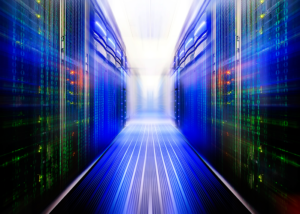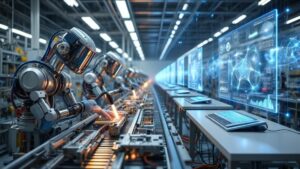- AI models rely heavily on advanced compute power—from GPUs and TPUs to cloud platforms and edge devices—to process large datasets, train models efficiently, and deliver real-time results.
- Energy consumption is a growing challenge for AI infrastructure, with companies focusing on more efficient hardware, optimized algorithms, and renewable energy solutions to reduce environmental impact.
- Emerging trends like quantum computing, distributed AI, and specialized processors are set to enhance performance, enabling new breakthroughs in AI applications across industries such as healthcare, finance, and autonomous systems.
Artificial intelligence (AI) has become essential in various sectors, from healthcare to finance, thanks to advancements in computational power. As AI models grow more sophisticated, the infrastructure required to support them must also keep up.
The speed, efficiency, and effectiveness of AI depend heavily on the ability to process large datasets and train complex models. Compute power serves as the engine that enables AI systems to operate at the level required for advanced tasks, such as language translation, autonomous vehicles, and predictive analytics.
This article dives into the significance of compute power in AI development, explores the different types of infrastructure used, discusses challenges and energy considerations, and examines the trends shaping the future of computing for AI.
1. The Role of Compute Power in AI Development
Compute power allows AI systems to perform a series of intensive operations necessary for tasks like training deep learning models. These models are built by processing enormous datasets, often requiring multiple iterations to improve accuracy. The more computational resources available, the faster these models can be trained. Without sufficient processing capability, AI development slows considerably, making it difficult to deploy models on time or at the required performance levels.
For example, the development of autonomous vehicles depends on AI models trained on millions of images and hours of video footage. Processing this data efficiently requires high-performance GPUs (Graphics Processing Units) to run multiple operations in parallel. Similarly, AI-powered chatbots that provide real-time customer service use compute resources to analyze incoming messages and generate relevant responses instantaneously.
Computational limitations can also restrict the capabilities of AI models. Smaller models that use limited compute power may struggle to deliver the same accuracy as larger ones. This makes high-performance computing essential not only for developing more advanced systems but also for ensuring reliability in real-world applications.
2. Types of Compute Infrastructure Supporting AI
AI models rely on several types of infrastructure, each suited for specific use cases. Below are the most common types of infrastructure and their roles in AI development:
High-Performance Computing (HPC)
HPC systems combine multiple processors to tackle intensive tasks, such as training large machine learning models. Research institutions and enterprises often use HPC clusters to process vast datasets efficiently. For example, pharmaceutical companies use HPC to model drug interactions, while financial institutions rely on it for fraud detection algorithms.
GPUs vs. TPUs
- GPUs: Graphics Processing Units excel at handling the parallel computations required for deep learning. These processors are widely used in fields such as computer vision and natural language processing.
- TPUs: Tensor Processing Units, developed by Google, are optimized specifically for machine learning workloads. They offer higher efficiency for specific AI tasks, such as training large neural networks.
Both types of processors are essential in AI development, with GPUs offering flexibility and TPUs providing faster performance for targeted applications.
Cloud Computing
Cloud platforms like AWS, Google Cloud, and Microsoft Azure allow organizations to rent compute power as needed. This flexibility makes it easier for companies to scale AI projects without investing in expensive on-premise infrastructure. Cloud services are particularly useful for startups and smaller teams that require access to powerful tools without high upfront costs.
Edge Computing
Edge computing involves processing data locally, closer to where it is generated, rather than relying on centralized servers. This method reduces latency, which is critical for real-time applications like self-driving cars or IoT devices.
In healthcare, for example, edge computing allows medical devices to process data quickly, supporting immediate decision-making in emergencies.
These different types of infrastructure ensure that AI systems are well-supported, no matter the application or scale of the project.
3. How Compute Power Enables Large AI Models
Large-scale AI models such as GPT-4, BERT, and DALL·E have transformed fields like natural language processing and creative generation. However, these models require massive computational resources to train. Training GPT-4, for example, involves billions of parameters and requires access to multiple GPUs or TPUs running simultaneously over extended periods.
The demand for compute power increases with the size of the model. Larger models tend to perform better because they can process more information and make more nuanced decisions. However, this also means that the computational cost rises exponentially. In addition to training, deploying these models efficiently requires significant resources to handle large volumes of requests without lag. For instance, AI chatbots deployed at scale must respond to hundreds or thousands of queries per second.
Without access to powerful computing infrastructure, these large models would not be feasible. Compute power ensures that AI models continue to push boundaries, enabling breakthroughs in speech recognition, predictive modeling, and content generation.
4. Compute Power and Energy Efficiency Challenges
While advanced computing drives AI forward, it comes with significant energy consumption challenges. Data centers housing thousands of servers consume vast amounts of electricity. Training one large AI model can produce as much carbon as several flights across the Atlantic Ocean. As AI adoption grows, so does the environmental impact of its compute requirements.
To reduce the carbon footprint, technology companies are exploring more energy-efficient solutions. Google’s TPUs have been designed with efficiency in mind, and NVIDIA continues to release GPUs that offer improved performance with reduced power consumption. Additionally, companies like Microsoft are experimenting with renewable energy sources to power their data centers.
Researchers are also developing optimization techniques that reduce the number of computations required to train models, further cutting energy usage. Striking a balance between computational power and sustainability is essential for the responsible development of AI.
5. Cloud Computing vs. On-Premise Infrastructure for AI
Cloud computing has become a popular choice for organizations developing AI solutions, offering access to advanced resources without the need for costly physical infrastructure. The pay-as-you-go model provided by cloud platforms allows companies to scale their compute needs based on demand. This flexibility is particularly beneficial for AI startups, which can launch projects with minimal capital investment.
However, on-premise infrastructure still holds value, especially for organizations handling sensitive data. Healthcare providers, for example, often prefer on-premise systems to comply with strict data privacy regulations. Financial institutions may also choose on-site infrastructure to maintain complete control over their AI models and data. Hybrid approaches, combining cloud and on-premise resources, are becoming common as businesses seek to optimize both cost and performance.
6. The Impact of Compute Power on AI Research and Innovation
Research in AI would not be possible without access to high levels of compute power. Advanced computing enables researchers to experiment with new algorithms, analyze vast datasets, and test models more efficiently. This capability accelerates innovation in fields ranging from robotics to healthcare.
For example, OpenAI relies on extensive computing resources to develop and improve its language models. Autonomous vehicle companies like Tesla use powerful AI systems to process sensor data, refine driving algorithms, and improve vehicle performance. Academic institutions also benefit from compute power, with AI labs conducting experiments that advance knowledge in areas like environmental modeling and personalized learning.
7. Trends Shaping the Future of Compute Power in AI
Several trends are emerging in the field of AI computing, promising to shape the future:
- Quantum Computing: Although still in development, quantum computing could solve problems much faster than traditional computers, opening new possibilities for AI applications.
- AI-Specific Hardware: Companies are designing chips optimized for AI workloads, such as neuromorphic processors that mimic the brain’s neural networks. These processors aim to provide faster, more efficient computing for AI tasks.
- Distributed Computing: Distributed AI models spread computational tasks across multiple devices, improving processing speeds and reducing bottlenecks.
- Edge AI: The growth of edge computing continues, with devices such as smart cameras and industrial sensors running AI models locally to deliver real-time results.
These advancements will make AI systems even more capable and efficient, enhancing their application across industries.
Takeaway: The Compute Power Driving AI Innovation
The progress of AI relies heavily on access to powerful computing infrastructure. From training large models to deploying AI applications at scale, compute power ensures that AI systems can meet the demands of modern tasks. However, the need for performance must be balanced with sustainability, as the energy consumption of data centers continues to rise.
By adopting energy-efficient technologies and exploring new approaches such as quantum computing and edge AI, organizations can support both performance and environmental goals. As compute power evolves, it will open new doors for research and applications, allowing AI to make even greater contributions across industries.
Compute Power: People Also Ask
- Why is compute power important for AI?
Compute power ensures that AI models can process large datasets quickly, resulting in faster training and higher performance. - What is the difference between GPUs and TPUs?
GPUs handle parallel processing tasks, making them ideal for deep learning, while TPUs are optimized for machine learning tasks, offering faster performance for specific models. - How does cloud computing support AI?
Cloud platforms offer scalable access to advanced computing resources, reducing the need for expensive physical infrastructure. - What environmental challenges does AI computing face?
AI models require significant energy, but companies are working toward energy-efficient solutions through optimized hardware and renewable energy. - What trends will shape the future of compute power in AI?
Emerging technologies like quantum computing and neuromorphic chips will enhance performance and efficiency in AI systems.
Further Reading
To gain a deeper insight into the role of compute power in AI innovation, the following resources offer valuable perspectives on computational advancements, specialized hardware, and the environmental considerations of large-scale AI models.
OpenAI: AI and Compute
This article explores how the growth in computational resources has accelerated AI advancements, discussing the implications of compute power in AI development.
Google Cloud: Cloud TPUs
Learn about Tensor Processing Units (TPUs), specialized hardware developed by Google to optimize machine learning workloads and improve efficiency.
MIT Technology Review: The Carbon Footprint of Machine Learning
This article examines the significant energy consumption and environmental impact associated with training large AI models, highlighting the need for more sustainable practices.









